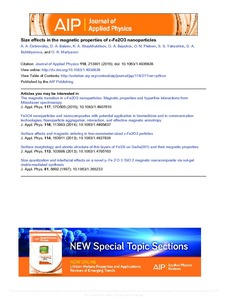Показать сокращенную информацию
Size effects in the magnetic properties of ε-Fe2O3 nanoparticles
| Автор | Dubrovskiy, A. A. | |
| Автор | Balaev, D. A. | |
| Автор | Shaykhutdinov, K. A. | |
| Автор | Bayukov, O. A. | |
| Автор | Pletnev, O. N. | |
| Автор | Yakushkin, S. S. | |
| Автор | Bukhtiyarova, G. A. | |
| Автор | MartyanovO. N. | |
| Дата внесения | 2017-06-16T10:30:27Z | |
| Дата, когда ресурс стал доступен | 2017-06-16T10:30:27Z | |
| Дата публикации | 2015-12 | |
| Библиографическое описание | Dubrovskiy, A. A. Size effects in the magnetic properties of ε-Fe2O3 nanoparticles [Текст] / A. A. Dubrovskiy, D. A. Balaev, K. A. Shaykhutdinov, O. A. Bayukov, O. N. Pletnev, S. S. Yakushkin, G. A. Bukhtiyarova, MartyanovO. N. // Journal of Applied Physics. — 2015. — Т. 118 (№ 21). — С. 213901 (12 p.) | |
| ISSN | 00218979 | |
| URI (для ссылок/цитирований) | https://elib.sfu-kras.ru/handle/2311/33165 | |
| Описание | Текст статьи не публикуется в открытом доступе в соответствии с политикой журнала. | |
| Аннотация | We report the results of comparative analysis of magnetic properties of the systems based on ε-Fe2O3, nanoparticles with different average sizes (from ∼3 to 9 nm) and dispersions. The experimental data for nanoparticles higher than 6–8 nm in size are consistent with the available data, specifically, the transition to the magnetically ordered state occurs at a temperature of ∼500 K and the anomalies of magnetic properties observed in the range of 80–150 K correspond to the magnetic transition. At the same time, Mőssbauer and ferromagnetic resonance spectroscopy data as well as the results of static magnetic measurements show that at room temperature all the investigated samples contain ε-Fe2O3 particles that exhibit the superparamagnetic behavior. It was established that the magnetic properties of nanoparticles significantly change with a decrease in their size to ∼6 nm. According to high-resolution electron microscopy and Mőssbauer spectroscopy data, the particle structure can be attributed to the ε–modification of trivalent iron oxide; meanwhile, the temperature of the magnetic order onset in these particles is increased, the well-known magnetic transition in the range of 80–150 K does not occur, the crystallographic magnetic anisotropy constant is significantly reduced, and the surfacemagnetic anisotropy plays a decisive role. This is apparently due to redistribution of cations over crystallographic positions with decreasing particle size, which was established using Mössbauer spectra. As the particle size is decreased and the fraction of surface atoms is increased, the contribution of an additional magnetic subsystem formed in a shell of particles smaller than ∼4 nm becomes significant, which manifests itself in the static magnetic measurements as paramagnetic contribution | |
| Ссылка на другой сайт | http://scitation.aip.org/content/aip/journal/jap/118/21/10.1063/1.4936838 | |
| Название | Size effects in the magnetic properties of ε-Fe2O3 nanoparticles | |
| Тип | Journal Article | |
| Тип | Published Journal Article | |
| Страницы | 213901 (12 p.) | |
| ГРНТИ | 29.19.41 | |
| Дата обновления | 2017-06-16T10:30:27Z | |
| DOI | 10.1063/1.4936838 | |
| Институт | Институт инженерной физики и радиоэлектроники | |
| Подразделение | Кафедра общей физики | |
| Журнал | Journal of Applied Physics | |
| Квартиль журнала в Scopus | Q2 | |
| Квартиль журнала в Web of Science | Q2 |

